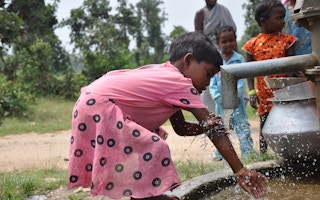Covid-19 has, like nothing before, exposed the fragility of the systems that underpin our globalized world, revealing just how quickly they can unravel with devastating and far-reaching impacts.
As people around the world work to understand the implications of the pandemic, it’s clear that water is central not only to these systems, but also to our ability to respond to Covid-19, restore growth and build resilience in a post-pandemic world.
If humanity really is to “build back better” to prevent and preempt future shocks, then governments, companies and civil society must value and invest in water security worldwide.
“
The fabric of water security is created by weaving together effective governance, knowledge and skills, connectivity across systems, and investment in and application of infrastructure, technologies and services from ecosystems.
Immediate Needs
Inadequate water supply and sanitation deprive communities of the most basic hygiene measure that helps prevent the spread of disease: handwashing. As a result, Covid-19 is shining an unforgiving spotlight on the inequalities, hardships and global health risks that stem from our failure to uphold the human right to water and sanitation worldwide.
In its 2019 report “Safer Water, Better Health,” the World Health Organisation (WHO) states that improving water, sanitation and hygiene could reduce at least 4.6 per cent of global disease rates and 3.3 per cent of all deaths. But still, 4.2 billion people lack adequate sanitation and 3 billion do not have access to needed handwashing facilities.
Waterborne infections cause diarrheal diseases and poor hygiene blocks nutrient absorption, so even those with access to nutritious food may face malnutrition because of water inequality. In the current circumstances, where handwashing is limited and waterborne illness is already common, the lethality of Covid-19 could be amplified.
We should also be cognizant of gender implications. In many parts of the world, women and girls spend hours each day fetching water or waiting in crowded queues for water vendors, potentially getting exposed to the virus.
If they struggle to bring water because they are ill or have to care for the sick, their health and food security could be further compromised. And, to compound the issue, restrictions on movement may lessen ability to access water at all.
In the short term, governments and international agencies should prioritise safe and reliable water supply and sanitation. This includes emergency provision for underserved communities and protecting individuals responsible for fetching water from exposure to the virus.
We also need to improve understanding of where and how municipal or rural water infrastructure is coping with spikes in demand because of the virus so that this can be properly managed to avoid shortages, likely to impact the most vulnerable.
Medium-Term Threats
In the pandemic recovery effort, among the most critical priorities will be securing irrigation water for farms that may have missed a planting season without undermining basic domestic water needs, while also mitigating the risks of droughts, floods and other weather extremes.
This will require water management to reinforce the stability of food systems while also recognising the prospect of overlapping shocks, both natural and human-made, placing added pressure on food production.
Water risks to food systems and across economies lurk in locations where, to counter deficits in food supply, dry season cropping expands and water demand for irrigation spikes just as demand for water surges in reopening economies and cities.
Floods and drought will not be put on hold for the pandemic. When people are displaced by such natural disasters, authorities often establish densely populated camps or shelters, clearly not a viable option now. Fortunately, we can monitor and forecast water-related risks, and authorities can use the resulting data to help with recovery and initiate mechanisms like index-based weather insurance that can support poor and vulnerable people in times of such crises.
The prospect of broader coincident shocks is another concern. In January the World Economic Forum published its annual “Global Risks Report,” which ranked risks from water, infectious disease and food security issues. In 2020, there will likely be places where we see all three at once.
To ensure that water-related risks do not compound the challenge of pandemic recovery through crop failures, unmanaged competition for water, or unanticipated droughts or floods, countries will need to reinforce water governance. This will underpin reliable delivery of water for priority uses such as agriculture, public health and industry.
They also will need to enhance water storage and irrigation capacity to compensate for disruptions to rain-fed agricultural cycles, and strengthen drought and flood risk management strategies to protect farmers, communities and economies from multiple concurrent food system shocks.
Building Back Better
In the post-pandemic era, we must use what we are learning about the dynamics of global, interconnected systems to “build back better.” Both the public and private sector must invest in water to create greater resilience to climate, health and food system shocks, and to improve management of water-related risks.
This means, among other things, calling for more circular water systems that secure supplies and better capture, clean and reuse resources in ways that protect human and ecosystem health.
It means reimagining our waste streams as resource streams so that instead of releasing 80 per cent of the world’s wastewater back into the environment untreated, we invest in treatment that will protect our communities and ecosystems against biological hazards and safely recycle water, energy and nutrients at the same time.
While there is currently no evidence that Covid-19 can spread through water or wastewater, we do know that historical epidemics have been transmitted in this way and that untreated wastewater remains a health hazard in too many communities today.
We are already hearing calls for greater food self-sufficiency as people experience disruptions in food trade and transport. In some cases this may provide greater resilience, shortening supply chains and buffering nations against changes in the agricultural and food policies of trading partners.
But shorter supply chains could also increase vulnerabilities — for example, to droughts, floods and crop diseases. Food self-sufficiency, moreover, may drive unsustainable water use because food import strategies are often driven by inadequate water supplies for local production.
If the “virtual water” embedded in food imports is replaced by unsustainable local water use, the availability of water for drinking, agriculture, ecosystems and a host of other urgent uses could be compromised.
Now, we must look to the future with a new and deeper appreciation of the value of resilience and the complex interconnected and interdependent systems that govern our lives and the economy. From here on, we will need to be systems-minded, not single-minded.
It is vital not to lose sight that water connects health, food systems, climate change, nature, energy and finance. The fabric of water security is created by weaving together effective governance, knowledge and skills, connectivity across systems, and investment in and application of infrastructure, technologies and services from ecosystems.
If we are to thrive in the post-pandemic world, we must work now to strengthen each of these components and ensure they are used in concert to reinforce resilience.
Claudia Sadoff is director general of the International Water Management Institute (IWMI). Mark Smith is deputy director general of the International Water Management Institute (IWMI). This article was originally published on Ensia.














